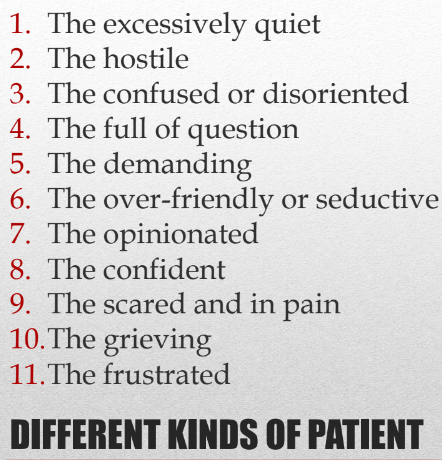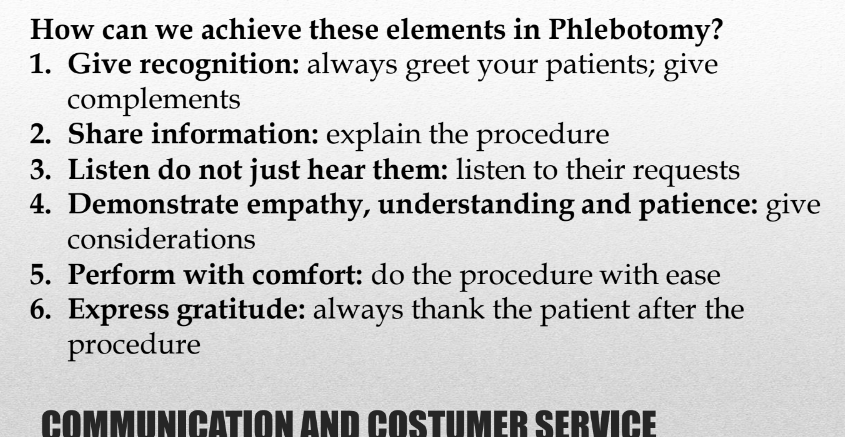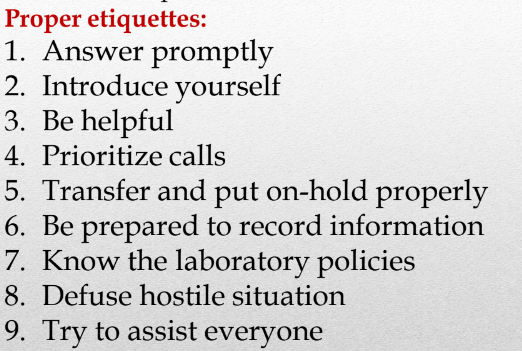Intro To Phleb
Phlebotomy (3)
venipuncture
arterial puncture
capillary/dermal puncture
Methods of Bloodletting (2)
Generalized method (2)
venesection
arteriotomy
Localized method (1)
scarification with cupping and leeches.
In the Philippines, a phlebotomist must meet the following recognition to practice phlebotomy:
Registered Medical Technologist
Registered Medical Laboratory Technician
Graduate of Medical Technology or Medical Laboratory Science
Graduate of other health professions and has undergone intensive
training for phlebotomy (including blood bank phlebotomy)
The phlebotomy profession emerged as an expansion to Medical Technology
Obtaining blood for diagnostic purposes
Remove blood for transfusion at donation centers
Remove blood for therapeutic purposes
Hippocrates Treatment Includes (4)
bloodletting
purging
catharsis
diuresis
TRADITIONAL DUTIES AND RESPONSIBILITIES OF A PHLEBOTOMIST
Demonstrate professionalism by their conduct, appearance,
composure and communication skills.
Know the facility’s policies and procedures.
Properly identify patients.
Collect both venous and capillary blood specimens.
Select the appropriate and accurate specimen container for
specified tests.
Properly label, handle, and transport specimens following its
policies.
Sort specimens received and process specimen for delivery to each
laboratory sections.
Perform computer operations and/or update log sheets where
require.
Perform basic laboratory procedures including preparation of
reagents, care and maintenance of glassware and preparation of
laboratory specimen for testing.
Observe all safety regulations and always practice confidentiality.
Attendance in a Continuing Professional Education
ADDITIONAL DUTIES & RESPONSIBILITIES OF A PHLEBOTOMIST
Training of other HCPs to perform phlebotomy
Monitoring the quality of samples collected on the units
Evaluation of protocols associated with specimen collection
Performing and monitoring of Point of Care Testing
Performing Electrocardiogram (ECG
Performing of measuring patient’s vital sign
Collection of arterial blood sample
Collection of samples from central venous access devise
Performing therapeutic phlebotomy
PROFESSIONAL TRAITS (Phlebotomist are Laboratory Ambassadors)
Accurate and Precise
Good Communication Skills
Organized, Responsible and Flexible
Integrity, Honesty & Competence
Professional Appearance
Compassionate, Courteous & Respectful
Self-Motivated
Dependable, Cooperative & Committed
COMMUNICATION IN HEALTH CARE SETTING
Communication components
verbal
active listening
non-verbal (4)
Kinesics
Proxemics
Appearance
Touch

Elements of Communication in Healthcare (4)
Empathy
Control
Respect & Confirmation
Trust

Telephone Communication

 Knowt
Knowt